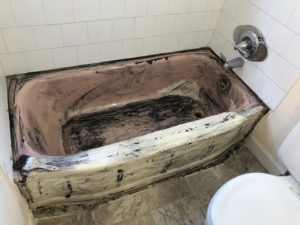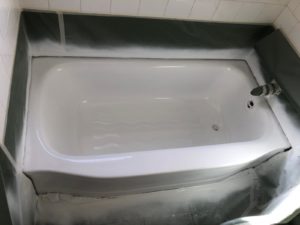Is the enamel peeling off your bathtub? You will be surprised to find out that this happens to a lot of people every year. There are many, many things that can cause a tub’s enamel to peel off. And peeling is not the only problem homeowners encounter. In this blog post, we will discuss some of the most frequent problems with tub enamel, as well as some solutions to the problem. Out of these solutions, one works better than all the others – and it’s a lot cheaper too. Read on!
Frequent Enamel Problems
Problems with enamel are as old as bathtubs. Of course, some tubs don’t have enamel – but we’re not talking about those. The ones that doo can start having problems with their enamel in just 3 or 4 years. Higher end models can last up to 6 years or even more. However, you will inevitably notice some enamel problems. Here are the most frequent of them:
- The enamel starts to peel off. This can happen in just a few places or across the entire surface of the tub. The enamel will start to peel faster in places where the tub has been damaged (chips, cracks, acidic solution burns, and so on).
- The enamel will start to change its color. From the shiny white we all love, it will slowly but surely turn to an ugly yellow or brown. Over time, the enamel is affected by the mineral deposits (especially if you live in a hard water area).
- Over time, the enamel will start to get damaged. Every time you drop something in the tub, the enamel gets chipped. It’s only a matter of time before the damage starts to become too extensive to overlook.

What Can You Do to Stop Enamel Peeling?
But what do you do when the enamel is yellow or when it starts to peel off? There are several solutions available, of course. If the enamel has changed its color because of the mineral deposits, you can try your luck with vinegar and baking soda. However, don’t expect outstanding results. If the enamel has peeled off, you can give a do it yourself tub repair kit a try. However, this is just a temporary solution because the new coating will start peeling off in around one year.
The extreme solution to all enamel problems is to simply replace the bathtub. However, this will set you back around $2,000 (including plumbing work and waste removal). You will also make a mess in your bathroom. If you don’t want any DIY solutions or solutions that involve construction work, you will be thrilled to learn that there is another option: reglazing.
The Reglazing Solution
Bathtub reglazing has become a very popular solution for people who want to bring their old tub back to life without replacing it. If you want a durable solution, refinishing is your best choice. During the reglazing process, the enamel is removed completely through sanding and all the cracks and chips are repaired. One or two layers of primer and bonding agents are applied to the surface of the tub. The final step is the coating, which is applied in one or two layers. Once the coating cures, your tub will look just like a brand new one.
Benefits of Resurfacing a Tub
So, why would you choose to resurface a bathtub instead of replacing it? Here are just some of the most significant benefits:
- You don’t have to do any construction work, so you don’t have to pay for plumbing work and waste removal.
- Reglazing a tub is much cheaper than replacing it.
- The refinishing process is environmentally friendly. You don’t have to send the old tub to the landfill anymore.
- The tub will look like brand new and you can even choose to change its color.
- You can reglaze other fixtures, such as the sink and toilet. You can also reglaze floor and wall tiles.

As you can see, reglazing a bathtub is clearly the best option for people who are starting to notice problems with the tub’s enamel. Are you looking for the best tub refinishing service in NYC? Get in touch with us today.


